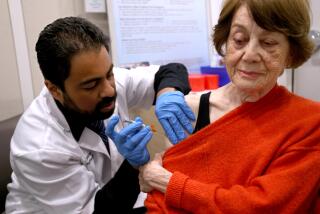Annual Flu Season Comes in Quietly
- Share via
California’s flu season is arriving late and has been relatively mild so far, especially compared with the severe outbreak last year that left hospital emergency rooms overflowing, health officials said last week.
“It’s really only been in the past two weeks that things have started to pick up,” said Michael Hendry, chief of the respiratory, AIDS and support section in the state Department of Health Services office in Berkeley. “It’s mild to moderate so far.”
Nationwide, the winter flu season, with its miseries of high fevers, aches and pains, also has been mild. But things could get worse in the next few weeks, federal health officials cautioned.
In California, cases are cropping up statewide.
“We have laboratory-confirmed cases from all the major population counties from San Diego up to Orange, Los Angeles, San Bernardino and all around the Bay Area,” he said. Other counties with confirmed cases include Sacramento, Butte, Contra Costa, San Mateo, Santa Clara and Solano.
Hendry said the flu is likely also to be hitting more rural areas, like Alpine County, which lack major medical centers with the ability to isolate the strains in the laboratory.
The flu types being detected in California are primarily the A Sydney type, as well as the B Beijing type. This year’s vaccine formula protects against both. Last year, the vaccine didn’t protect against the A Sydney type, which affected many Californians.
Hendry said health officials also are investigating an outbreak of a half influenza A and half influenza B type that struck in San Francisco.
In Los Angeles, county health officials are breathing sighs of relief that they’re not seeing a repeat of last year’s ER-busting flu epidemic. This year, they estimate there are less than half as many cases.
“We didn’t see significant flu until about the first week in January, which is a week to two weeks down the line from where we peaked last year,” said Dr. Shirley Fannin, director of disease control for the Los Angeles County Department of Health Services. “Last year, we had our heaviest the last two weeks in December.”
Fannin said she’d “love to believe” that the cases are down this year because “we got enough people immunized,” but she said that is not the likely explanation.
“Some people think it’s also because we’re really not having winter yet. We’re having warm weather. People didn’t go indoors and close windows and start rebreathing each other’s air.”
In Orange County, “so far, it’s been kind of quiet,” said Dr. Hildy Meyers, the county’s medical director of communicable disease control and epidemiology.
In Ventura County, immunization coordinator Lin Glusac said there have been very few cases, except in Ojai, where cases increased in the last couple of weeks.
Nationwide, the federal Centers for Disease Control and Prevention said flu activity had increased since mid-December, with influenza outbreaks occurring in 10 states and New York City, and reports of flu in 35 other states.
“We have received increased reports of activity in the first couple of weeks of 1999,” said Dr. Tim Uyeki of the CDC’s National Center for Infectious Diseases.
The CDC recommends that the elderly, people with lung and heart disease or other chronic medical conditions, and people who care for or live with them, should get a flu vaccine.
“The optimal time for getting the flu shot is in the fall, between September and November, but we would recommend that any unvaccinated person, especially those people who are at high risk of complications from the flu, should strongly consider getting a flu vaccine right now,” Uyeki said.
*
Reuters contributed to this report.
More to Read
Sign up for Essential California
The most important California stories and recommendations in your inbox every morning.
You may occasionally receive promotional content from the Los Angeles Times.










